

China's Cultural Revolution. China rewrites history books to extend Sino-Japanese war by six years. China’s government has ordered that all Chinese history textbooks be rewritten to extend the second Sino-Japanese war by six years, a move likely to inflame relations with Japan.
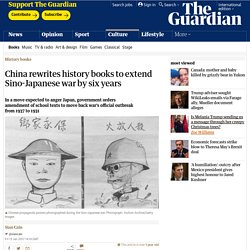
The conflict, which has been known for generations in China as the “eight-year war of resistance against Japanese aggression”, is usually recorded as starting in 1937 and ending in 1945. However, in a statement on Wednesday, President Xi Jinping’s government renamed the conflict the “14-year war of resistance against Japanese aggression” and has ordered that textbooks be revised to record it as lasting from 1931 until 1945.
The decision means China officially considers that the second Sino-Japanese war started in autumn of 1931, when the Imperial Japanese army invaded Manchuria, rather than six years later during the Marco Polo Bridge incident, when Japanese and Chinese troops fought along a rail line south-west of Beijing. “Chinese leaders still have a cold war mentality,” he said. The History of China – The Official Site of The History of China Podcast. China's Cultural Revolution: Rewriting a Nation. Map - Chinese Civil War. Stuff You Missed in History Class. INFOGRAPHIC: The Long March. From Reform to Revolution, 1842 to 1911. Introduction After China's defeat in the Opium War, there was great concern about the superiority of the West and fierce debate about how to respond.

In 1842 Wei Yuan (1794-1856), a scholar and adviser to the government, concluded that the West had beset China because of the West's more advanced military technology. He outlined a plan for maritime defense which included "building ships, making weapons, and learning the superior techniques of the barbarians. " In the decades that followed, other scholars went further than Wei, calling not only for the purchase and eventual manufacture of Western arms but also for the establishment of translation offices and institutions where students could study Western languages and mathematics in addition to Chinese classics. This approach came to be known as "self strengthening;" its principle goal was to maintain the strong essence of Chinese civilization while adding superior technology from abroad. | back to top |
Hello adblock user... The webserver at Alpha History tells us you’re using an adblocking tool, plug-in or browser extension on your computer or network.

We understand that many people don’t like web-based advertising. Ads on websites can often be irrelevant, distracting and ‘in your face’. Without ads, however, our website would not exist – or it would not be free. Ads are how we fund the creation and delivery of our content. We love providing free textbook-quality content and resources to people like you. If you would like to use our website and its resources, please disable your adblocker or whitelist our website. Selected Works of Mao Zedong. All Works by Date | IndexVolumes I through V published by Foreign Languages Press, Peking, China.
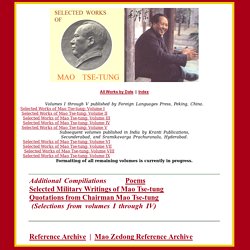
Selected Works of Mao Tse-tung: Volume I Selected Works of Mao Tse-tung: Volume II Selected Works of Mao Tse-tung: Volume III Selected Works of Mao Tse-tung: Volume IV Selected Works of Mao Tse-tung: Volume V Subsequent volumes published in India by Kranti Publications, Secunderabad, and Sramikavarga Prachuranalu, Hyderabad. THE CHINESE REVOLUTION AND THE CHINESE COMMUNIST PARTY. Selected Works of Mao Tse-tung December 1939 [The Chinese Revolution and the Chinese Communist Party is a textbook which was written jointly by Comrade Mao Tse-tung and several other comrades in Yenan to the winter of 1939.
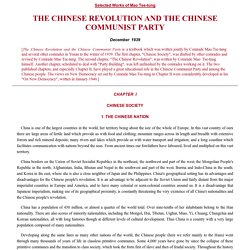
The first chapter, "Chinese Society", was drafted by other comrades and revised by Comrade Mao Tse-tung. The second chapter, "The Chinese Revolution", was written by Comrade Mao Tse-tung himself. Another chapter, scheduled to deal with "Party Building", was left unfinished by the comrades working on it. THE CHINESE REVOLUTION AND THE CHINESE COMMUNIST PARTY. The Three Principles of Sun Yixian (1923) Sun Yat - Sen, The Three Principles of the People. Sun Yat–Sen, The Three Principles of the People Sun Yat–Sen (1866–1925) was a Chinese doctor who led the revolution against the Qing dynasty in 1911.
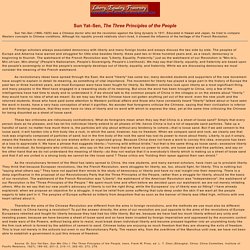
Educated in Hawaii and Japan, he tried to compare Western concepts to Chinese conditions. Although his republic proved relatively short–lived, it showed the influence of the heritage of the French Revolution. Foreign scholars always associated democracy with liberty and many foreign books and essays discuss the two side by side. The peoples of Europe and America have warred and struggled for little else besides liberty, these past two or three hundred years and, as a result, democracy is beginning to flourish. As revolutionary ideas have spread through the East, the word "liberty" has come too; many devoted students and supporters of the new movement have sought to explain in detail its meaning, as something of vital importance.
These two criticisms are ridiculously contradictory. Source: Dr. <STRONG>Xinhai Revolution</STRONG> The Revolution of 1911, or the Xinhai Revolution, began as the Wuchang Uprising in 1910.
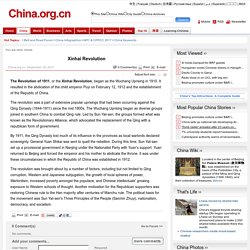
It resulted in the abdication of the child emperor Puyi on February 12, 1912 and the establishment of the Republic of China. The revolution was a part of extensive popular uprisings that had been occurring against the Qing Dynasty (1644-1911) since the mid 1800s. The Wuchang Uprising began as diverse groups joined in southern China to combat Qing rule. Milestones: 1899–1913. In October of 1911, a group of revolutionaries in southern China led a successful revolt against the Qing Dynasty, establishing in its place the Republic of China and ending the imperial system.
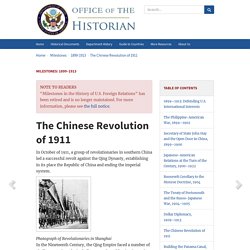
Photograph of Revolutionaries in Shanghai In the Nineteenth Century, the Qing Empire faced a number of challenges to its rule, including a number of foreign incursions into Chinese territory. The two Opium Wars against Western powers led by Great Britain resulted in the loss of Hong Kong, forced opening of “treaty ports” for international trade, and large foreign “concessions” in major cities privileged with extraterritorial rule. After its loss in the Sino-Japanese War (1894–95), Imperial China was forced to relinquish control over still more of its territory, losing Taiwan and parts of Manchuria and ending its suzerainty over Korea. The Russo-Japanese War (1904–05) firmly established Japanese claims to the Northeast and further weakened Qing rule.
Qing Soldiers. China. China is a major country in East Asia.

The population is predominantly ethnic Chinese (Han) with significant minorities in Tibert, Xinjiang and Mongolia. In 1644 China was ruled by the Qing dynasty and by the 18th century the country had become very prosperous. Several rebellions took place in the 19th century. Defeat in the Sino-Japanese War (1894) and the Boxer Rising encouraged reforms but the dynasty ended in the Chinese Revolution of 1911. Sun Yat-sen briefly became president and with Song Jiaoren established the Kuomintang (National People's Party). China 1900 to 1976. 1934: The Long March: Mao. "long march" What Was the Long March? Imagine leading your troops on a retreat through territory so deadly that it kills 90% of them.
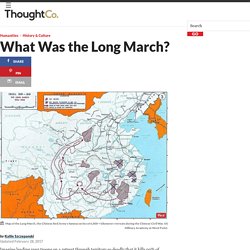
Imagine climbing through some of the highest mountain ranges on Earth, fording flooded rivers without any boats or safety equipment, and crossing rickety rope bridges while under enemy fire. Imagine being one of the soldiers on this retreat, perhaps a pregnant female soldier, possibly even with bound feet. The Long March 1934 to 1935.
The Long March saved Mao Zedong and the Communist Party from the attacks by the Guomingdang. The Long March came about when the Chinese Communists had to flee a concerted Guomingdang attacked that had been ordered by Chiang Kai-shek. In the autumn of 1933, the Guomindang leader Chiang Kai-shek launched a huge attack against the Communists who were then based in the Jiangxi and Fujian provinces in south-east China. The Guomindang was advised by the German general, Hans von Seeckt. He advised Chiang Kai-shek not to launch a full frontal attack on Jiangxi. 500,000 Guomindang troops surrounded Jiangxi in an attempt to strangulate the Communists.
Chinese history. Long March - Facts & Summary. With defeat imminent, the Communists decided to break out of the encirclement at its weakest points, and the Long March began on October 16, 1934. Secrecy and other tactics confused the Nationalists, and it was several weeks before they realized that the main body of the Red army had fled.
The retreating force initially consisted of more than 85,000 troops, by some estimates, and thousands of accompanying personnel. Weapons and supplies were borne on men’s backs or in horse-drawn carts, and the line of marchers stretched for miles. Republic of China 中華民國, 1912-1949. The Republic of China (Zhonghua minguo 中華民國, 1912-1949) was the official designation of the state that succeeded the last imperial dynasty, the Qing 清 (1644-1911). The Republic was founded in the hope to establish a modern state able to shake off the image of a decadent and antediluvian form of government and to enter the sphere of the international community. Yet from the beginning the Republic was beset with internal struggles.
President Yuan Shikai 袁世凱 and others tried to revive the monarchy, while the professional revolutionary, Sun Yat-sen (Sun Zhongshan 孫中山), was only able to control his home province of Guangdong. People's Republic Of China vs Republic Of China. The People's Republic of China is commonly known as China and the Republic of China is commonly known as Taiwan. These are separate states with a shared history; China claims sovereignty over Taiwan. PBS 中国:一个世纪的革命] PBS China A Century of Revolution 1 China In Revolution 1911 1949. 2,000 Years of Chinese History! The Mandate of Heaven and Confucius: World History #7. Khanacademy. Communists, Nationalists, and China's Revolutions: Crash Course World History #37. Chinese Revolution timeline. Chinese Revolution. Republic of China 1912 - 1949.
20th CENTURY: China in Revolution, 1912-1949.